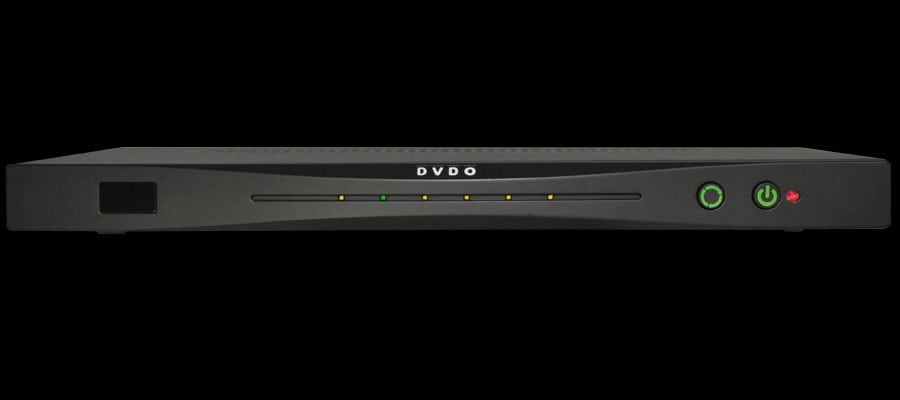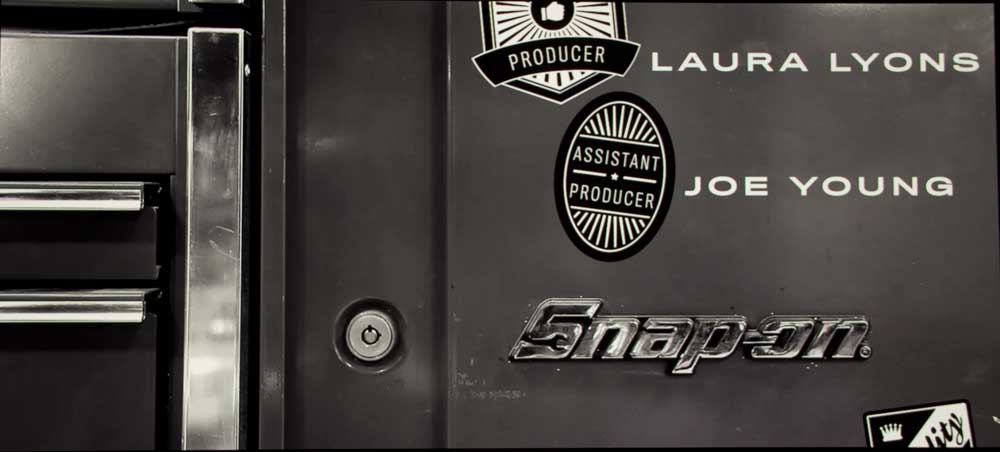DVDO Quick6R: Using the switcher, MHL, Insta-Prevue, Home and Commercial Use, Summary
Using the Quick6R 4K Switcher
Learning that the Quick6R was designed to work with 4K content, immediately my brain was shouting to me – Awesome, we can finally do side by side viewing between these two 4K projectors I have at the moment, while feeding them 4K content. At that time I had Sony's 4K media FMP-X10 media player that works with the current 4K download service out there, and I had many hours of content, including shorts, as well as movies such as MIB III and Spiderman III.

The Quick6R is extremely thin, and looks great compared to most other switchers.
Out came the extra cables, and in a couple of minutes I had the Quick6R wired up between the Sony media player, and the two projectors. I fired everything up, and…
Alas – it was not to be. Immediately I received an error message on the screen (coming from the media player) telling me that my display device was not compatible (with 4K content using HDCP 2.2 copy protection. Now, understand, the media player works fine with either the Sony or the Epson directly, so obviously the DVDO was the culprit.
The download service/media player uses HDCP 2.2, the latest copy protection standard, and one that everyone believes will be required for Blu-ray UHD (4K) as well. Well, the Quick6R was launched back in 2012, long before the HDCP 2.2 standard was set. So, for me, no side by side viewing for all that 4K content. Boy was I bummed!
I'll circle back to 4K a bit later in this review. Let’s talk 1080 resolution switching. Switching 1080p content – Blu-ray content from a Sony PS3 – and 1080i content – from my DirecTV satellite box – was effortless. The DVDO is very fast when it comes to switching (I wish projectors would switch that fast between two HDMI inputs.) That seems to be tied to the Inta-Port feature described later. Currently I own and use at any given moment, two switchers, one down in the testing room (a Gefen 4x2) where I do most of my side by side viewing.
Switching Audio over HDMI
There was one thing that some how never occurred to me the whole time I had the Quick6R here: I’m used to dealing with my HDMI sources and my digital audio sources separately, as many folks find they have to do. What I didn’t think to try was to send the audio from my sources to the DVDO Quick6R over HDMI. With luck, I would then be able to output the audio from the Quick6R over its single fibre-optic (Toslink) Digital Audio Out, to one of the Digital Audio inputs on my receiver. That ability would have been great, and reduced wire clutter, and generally mean I wouldn’t have to switch both video and audio separately.
Great news, a follow-up call to DVDO support provided the answer: Yes. I could bring the audio from all the sources in through HDMI, and output through the Digital audio out. That would have simplified my life, and simplified anyone else's life who has a similar setup. Good thinking DVDO!
MHL and Roku
I wanted to check out the “R” capability, that makes this a Quick6R, not the older Quick6 model. Well, as noted, the R stands for Roku, the first popular streaming stick. I have a Roku stick for my own use, and for testing purposes.
I plugged it into the back of the DVDO swtich in the #6 HDMI input and voila’ it worked! Both input #1 and #6 are designed to handle MHL devices, although it's #6 that DVDO indicates that is optimized for the Roku. So consider the others capable for MHL equipped devices in general, such as some android phones and tablets.
So, I’m pleased to report that I experienced no problems with feeding the DVDO switch standard 1080p or 1080i content including Blu-ray discs that use the older HDCP protection, and HDMI 1.4a. And as long as you stick to the two MHL ports, no issue using the only MHL streaming stick I have, the Roku, at least in terms of basic testing. I was able to get the menus up, and open Netflix. No problem.
Insta-Prevue, and Insta-Port
InstaPrevue Visual Switching
The DVDO offers a nice touch. Rather than choosing from a list of names: Input 1, 2, etc., you also have the option of InstaPrevue, which will basically show you thumbnail images of the active content on any inputs that have some. You get two choices in this mode, one offsets the active input being shown, the other just shows all of them in line with the selected one labeled. We are showing an image of the offset use. A very nice touch!
Insta-Port
This too is interesting technology as well. We’re all used to long delays – seconds, often 5 or more, for HDCP communication. DVDO states that Insta-port establishes immediate HDCP handshaking when the device is first active, even if not selected. That should make HDCP almost instantaneous when a new source is selected. While that has promise, your display and source devices likely aren’t that smart so you’ll still hit delays on their end. But who knows, we may see a day, yet, where copy protected HDMI instant switching really does become a reality.
The HDCP 2.2 Issue
True, overall, the Quick6R performed competently, even impressively. But it did fail me in one area. When first discussing it, I did not realize that it doesn't support HDCP 2.2 copy protection.
I really need a solution for 4K switching – and apparently, one that supports both HDMI 2.0 and HDCP 2.2. Looks like I’ll have to wait on that. The Quick6R's lack of HDCP 2.2 support should be carefully considered if you need a switcher for 4K content.
I’m pretty sure there are some very expensive commercial switchers out there that have the HDCP 2.2 support, but I can’t name any for you at this time. This DVDO, definitely doesn’t. I had asked DVDO if this unit would be upgradable. Things, of course could change but the answer was: No.
Unfortunately, shortly after the DVDO switch arrived, it was time to give Sony back their VW1100ES projector. Gone! Then in early April, I was able to borrow JVC’s top of the line home theater projector, the $12,495 DLA-RS6710. Here was a projector that can accept 4K, but, like the DVDO switch, no HDCP 2.2. It also used the older HDMI 1.4a. Then I started thinking a little harder. Many months before Sony had sent me what they called a small media server back when I had reviewed the VW600ES. That media server had video clips on it, that were not copy protected.
That reminded me that last fall, when I reviewed a pre-production Epson LS10000, they had sent me one of the RED (the digital cinema camera maker) 4K players.
A quick call to Epson, (with minimal begging), and 3 days later a RED player arrived. The content either did not have copy protection, or if it did, it was older, not HDCP 2.2. There wasn’t much content to work with, but you can see some images from it in both the Epson review and the JVC DLA-RS6710 reviews (more on that in a moment.) Here's an image from that 4K content that passed through the DVDO just fine:

A 4K image captured from a 4K clip off of a RED player
Time for me to see some 4K. I plugged the RED player into the Quick6R, and ran one HDMI cable to the Epson LS10000 and the other to the JVC RS6710U.
The menu appeared, and I selected a piece of 4K content.
Bingo. The 4 K content projected onto my screen from both the Epson LS10000, and from the JVC RS6710U, simultaneously. Success!
I am pleased to report then, that if you have any non-copy projected 4K content, (or possibly 4K content with older HDCP) and don’t need HDCP 2.2 compatibility, this DVDO Quick6R works! And it seems to work rather well.
Without the HDCP 2.2 capability, I expect that the Quick6R will find itself primarily in business/education/commercial applications, rather than home use.
I would expect most folks who care about 4K content will end up with Blu-ray UHD players, and that means HDCP 2.2. And that makes this an important consideration.
That said, there are some non-HDCP copy protection content you can use at home. I can use my camera to shoot 4K resolution images, and feed them into my Sony PS3 via USB thumb drive. Those would be output without HDCP 2.2 (of course, the PS3 is “barely” HDMI 1.4a, and HDCP 2.2 requires HDMI 2.0.
Who knows – broadcast 4K, and possibly 4K over satellite and cable – when they arrive, may not require the HDCP 2.2. We shall see.
Quick6R 4K Switcher - Summary
 All considered, the Quick6R is a well thought out, well functioning HDMI switcher with six inputs, two of which support MHL, and the device pays special attention to working with the MHL Roku stick. There are two HDMI outputs, split screen capability, and there is digital audio out (2) including one fibre-optic (Toslink connector).
All considered, the Quick6R is a well thought out, well functioning HDMI switcher with six inputs, two of which support MHL, and the device pays special attention to working with the MHL Roku stick. There are two HDMI outputs, split screen capability, and there is digital audio out (2) including one fibre-optic (Toslink connector).
The Quick6R's major claim to fame is that it supports 4K. It's downside, is that it's not a new device, and as such, does not support HDCP 2.2 which is about to be required for working with the new 4K Blu-ray standard - Blu-ray UHD.
Despite our reservation about HDCP 2.2 issues, we believe the Quick6R deserves one of our Special Interest awards. (If it did support HDCP 2.2, no doubt it would have garnered a Hot Product award, our highest product award.)
Warranty: In the US and Asia, the warranty is 1 year parts and labor, in the EU (including the UK) the warranty is 2 years parts and labor.
What to do, about HDCP 2.2 and Blu-ray UHD?
A work around: If you have multiple non-HDCP 4K content sources as well as lower resolution devices to switch, let the Quick6R handle the all of that switching. Feed the Quick6R output into one of your HDMI inputs on your 4K display. Then, if you were to have a single HDCP 2.2 device and content (Blu-ray UHD), plug that into the other HDMI.
That gives you a solution for all your source switching with this work around for
That makes sense, because these days, typically MHL only shows up on one HDMI port out of the two found on most projectors (and other displays). That would do the trick for someone who’s only 4K, HDCP 2.2 source is the forthcoming Blu-ray UHD.
The list price of this 4K switcher isn't low, but street prices seem to typically be under $300. That's a lot less than many commercial switchers that can't do any 4K. All considered, it's a reasonable price for the capabilities provided, especially since we've always found DVDO to make some pretty competent equipment.




